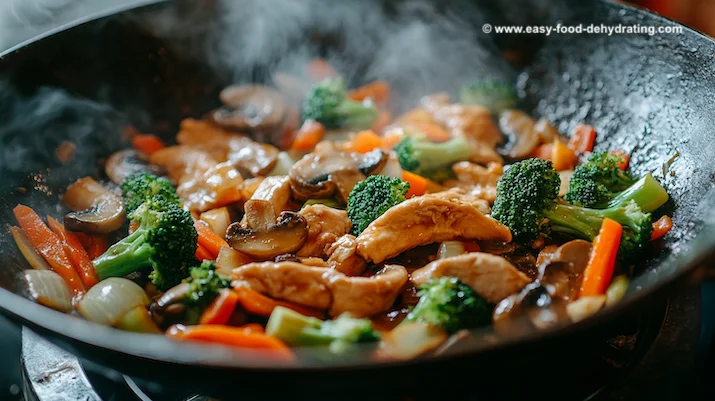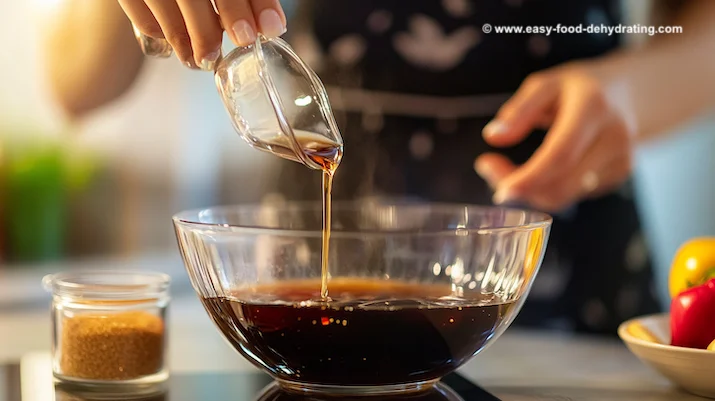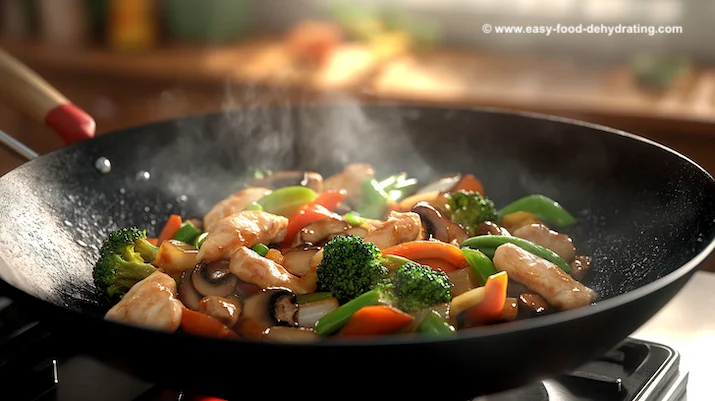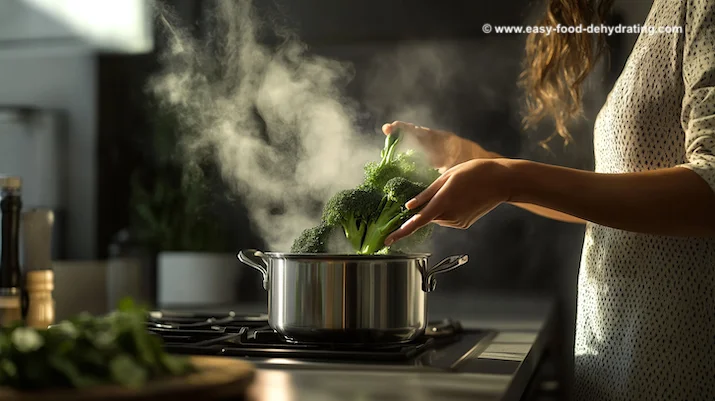- Home
- Easy Dehydrated Food Recipes
- Simple Stir Fry with Dehydrated Vegetables for Quick Meals
Simple Stir Fry with Dehydrated
Vegetables for Quick Meals

Susan Gast | Author, Blogger at Easy Food Dehydrating, Beesville Books, and A New Sober You
 Stir-fry chicken in a wok
Stir-fry chicken in a wokLooking for new weeknight dinner ideas? Try a stir-fry with dehydrated vegetables.
This quick method saves time on meal prep and cooking, especially if you're busy and want to make tasty, healthy meals without spending hours in the kitchen.
I mean who has time these days to spend slaving over a hot stove? (No offense to chefs).
The Benefits of Cooking with Dehydrated Vegetables
Dehydrated vegetables help simplify meal planning. Dried foods are light, they last a long time, and the best part to me is that they don't need refrigeration.
When I get home from the store, I prep all my fresh veggies in one sitting, if you will. Doing this makes sure they don't get enough time to go off!
Dehydrated vegetables work well in stir-fries, soups, and casseroles, making them ideal for dinners during the workweek.
Did you know that dried foods also keep most of their nutrients, providing good nutrition for your family?
Getting Started: Ingredients for Your Stir-Fry
 Ingredients for a chicken stir-fry
Ingredients for a chicken stir-fryFirst, we need to gather a few main ingredients for our dehydrated food stir-fry.
- Dehydrated vegetables (bell peppers, onions, carrots, mushrooms, and broccoli work well)
- Protein of your choice (chicken, beef, tofu, or shrimp)
- Aromatics (garlic, ginger)
- Cooking oil
- Stir-fry sauce (store-bought or homemade)
NOTE: The meat we're using is fresh, not dried. But first things first - we need to rehydrate the dried veggies.
Rehydrating Your Vegetables: Quick and Easy Methods
Yep - don't forget to add the water back into your dried veggies! And, as stated in point 2 below, use broth for added flavor, and my go-to stock of choice is always "Better Than Bouillon" by Superior Touch.
- Hot water method: Place your dehydrated veggies in a bowl and cover them with hot water. Let them soak for 10-15 minutes, or until they're tender.
- Broth method: For added flavor, use hot vegetable or chicken broth instead of water to rehydrate your vegetables.
- Steam method: Place the dehydrated vegetables in a steamer basket over boiling water and steam for 5-10 minutes until they're soft.
OK, I have to admit that I'm not a fan of rehydrating dried foods in hot water. You see, if you forget about them, you run the risk of germs showing up as germs love warmth... but honestly, my brain can handle a 15-minute wait.
When your dried veggies have plumped back up, toss the water/broth and allow the vegetables to drain. We don't want excess water getting in the way of our perfect stir-fry!
Pro Tip: Blanching for Vibrant Colors and Crispiness
If you love seeing bright red peppers, dark green broccoli, and gorgeous orange carrots, you might want to blanch your veggies BEFORE you dry them (yep going back to the beginning of prep when you get back home from the store!)
Blanching helps preserve their bright colors. Boil the veggies briefly, then transfer to a bowl of ice cubes and water to stop the cooking action.
Getting Good at Stir-Frying
Yep, it's all about technique. Let's aim for a restaurant-quality look'n'taste at home!
- Use a hot pan: Preheat your wok or large skillet over high heat before adding oil. This makes your food sear quickly, locking in flavor and giving us that stir-fry texture.
- Cook in batches: Don't overcrowd the pan. Doing so leads to steaming rather than frying. Cook your protein first, then set it aside and then stir-fry the vegetables.
- Keep things moving: Constantly stir and toss your ingredients to prevent sticking and burning. It also makes it look like you know what you're doing!
- Time it right: Add ingredients based on their fresh-state cooking times. Start with aromatics, then add the longer-cooking vegetables, followed by the faster-cooking items.
Layering Flavors for a Memorable Dish
 Chicken stir-fry, cooking in a wok
Chicken stir-fry, cooking in a wokTime to focus on the flavor... in "Time it right" (point 4) in the previous section, I mentioned aromatics and that means onions, and garlic (and not just herbs).
- Start with aromatic ingredients like garlic and ginger to create a flavorful base.
- Use a combination of soy sauce, oyster sauce, and sesame oil for depth and umami.
- Add a touch of sweetness with a sprinkle of brown sugar or a drizzle of honey.
- Finish with fresh herbs like cilantro or basil for a bright, fresh note.

Creating the Perfect Stir-Fry Sauce
 Making sauce for a stir-fry
Making sauce for a stir-fryA good stir-fry sauce makes all the difference, right? Here's a simple soy sauce recipe that goes well with dehydrated vegetables and meat:
- 1/4 cup soy sauce (regular)
- 2 tablespoons oyster sauce
- 1 tablespoon rice vinegar
- 1 tablespoon brown sugar
- 1 teaspoon sesame oil
- 1/4 cup water
How to make the sauce: Mix everything in a glass bowl - until you see and feel that the sugar has completely dissolved (no grittiness).
Add your sauce to your stir-fry near the end of cooking - stirring all the time until it thickens. Sauce a bit too runny for you? If you want your sauce to be a bit thicker, add some cornstarch but remember to mix the cornstarch with water by itself first!
Bear in mind, the cornstarch/water mix must be cooked out. The ratio is one tablespoon of cornstarch to two tablespoons of water.
Again, if the sauce is thin, add a tad more of the cornstarch/water mix, keep cooking and keep stirring!
SOY SAUCE
Nutrition Facts
Servings: 6
Calories: 21.2
Amount per serving
% Daily Value*
|
Total Fat: 0.8g |
1% |
% Daily Value*
|
Total Carbohydrates: 2.6g |
1% |
% Daily Value*
|
Vitamin D: 0mcg |
0% |
*The % Daily Value (DV) tells you how much a nutrient in a food serving contributes to a daily diet. 2,000 calories a day is used for general nutrition advice.
Quick and Easy Stir-Fry Recipe with Dehydrated Vegetables
Now we've got the sauce and proteins figured out, how about we get going with a full recipe how-to? Here are the steps:
- Rehydrate 2 cups of mixed dehydrated vegetables using your preferred method.
- Heat 2 tablespoons of oil in a wok or large skillet over high heat.
- Add minced garlic and ginger, stirring for 30 seconds until fragrant.
- Add the protein and cook until nearly done.
- Remove the protein and set it aside.
- Add the rehydrated vegetables to the pan and stir-fry for 2-3 minutes.
- Put the protein back in the pan and add your stir-fry sauce.
- Add sauce.
- Cook for an additional 1-2 minutes until everything is heated through and well-coated with sauce.
- Serve hot over rice or noodles.
NOTE: I have not provided the Nutritional Facts because I don't know how much and which veggies you are going to choose.

 Chicken stir-fry in a wok
Chicken stir-fry in a wokFor a true vegetarian version, skip the protein or replace it with tofu or tempeh.
Jeez, even though I ate lunch an hour ago, I can't wait to make a stir-fry right now!
Time-Saving Tips for Busy Moms
To make weeknight stir-fries even easier, try these time-saving tricks:
- Prep most of the ingredients in advance: Rehydrate vegetables and mix your sauce the night before or in the morning.
- Use leftover rice or noodles: Cook extra rice and noodles earlier in the week to reuse in your stir-fry.
- Keep a stir-fry kit in your pantry: Store dehydrated vegetables, sauces, and aromatics together for quick access.
- Incorporate leftovers: Use leftover cooked meats or vegetables in your stir-fry for a quick meal after a busy day.
Storing Your Dehydrated Vegetables
While you're here at Easy Food Dehydrating, what better time than right now to learn how to store dried food safely? Follow these four steps:
- Store dried foods in airtight Mason jars or food vacuum-sealer bags,
- Keep out of direct light. Mylar bags aid in that department...
- Use oxygen absorbers in your jars, and pop one in your food vacuum bags before drawing out the air - they keep oxidation at bay.
- Don't forget to write the date on the bag or jar label!
When you follow those four rules, your dried foods can last for months - years even - when dried properly. What a neat way to always have veggies (and fruits!) on hand.
My mouth is watering at the thought of making a stir-fry, and I hope it's got you eager to try a stir-fry, too. In no time flat, we'll be tossing and cooking our stir-fries like a pro.
The best part is there are endless ways to enjoy a stir-fry simply by changing out a veggie here and there. Oh, and maybe use beef instead of chicken, or how about pork, or thick chunks of ham?
Or go vegan. Either way, you're a stir-fry winner in my eyes!
Thanks for stopping by to read all about a simple stir-fry with dehydrated vegetables.
Before You Go...
If you like the content, please give me some love by clicking on the 🩷 in the lower right hand corner (on just about all my pages). This signals to me that you find it enjoyable and useful. Thank you so much!













